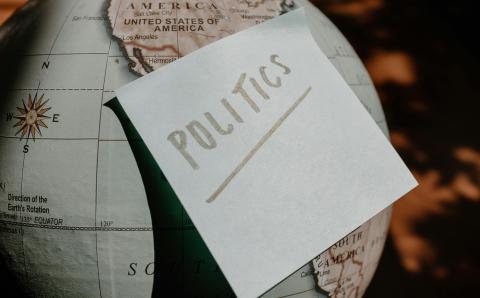From the wheel to sliced bread to the Internet, ideas have changed the landscape of our world. Creative ideas were the driving force behind the pyramids, Beethoven’s Symphony No. 9, and the discovery of penicillin. And ideas continue to be humankind’s means of changing the world.
No one is allowed to say "I'm not creative."
As a professor who teaches creativity, I have developed one simple rule for every class: “No one is allowed to say ‘I’m not creative.’” My goal is to refute the lie that some people are born creative while others are not. I want people to discover the gift God has given each of them and move them toward living a creative life, pursuing endeavors that can redeem the world, one creative act at a time.
Just as God’s creative work continues to sustain and redeem our world, each of us can use our creativity to bless the world—by running a business, writing a novel, tending a garden, or creating a brand-new invention that makes people’s lives a little easier.
Idea-Friendly Times
So what great ideas have you had lately? More important, where were you and what were you doing when you generated those ideas?
When I first heard of “idea-friendly times,” I thought the concept was a bit crazy. These are moments when our brain goes into an alpha state, creating space where ideas can germinate. The point is that certain places or activities allow us to be intentional about generating ideas. Thomas Edison and Salvador Dali, for example, used to put themselves into an alpha state by holding objects in their hands before falling asleep. When sleep was about to overtake them, these objects would fall to the floor, making a loud noise and waking them up—allowing them to consciously make space for dreaming up new ideas.
Similar idea-friendly times include activities like mowing the lawn, waking up in the middle of the night, listening to a sermon, exercising, driving, reading, daydreaming, or taking a shower.
I began to experiment with each one of those idea-friendly times for several weeks at a time. I soon discovered that some of them applied to me, while others did not. For example, when I wake up in the morning, I allow my mind five to 10 minutes to think about a specific creative endeavor I am pursuing—a game design, a screenplay, or a class I am developing. While not every morning produces earthshattering ideas, many do arise that are captivating or useful. In experimenting with these idea-friendly times, I soon learned that I had to be intentional about them in order for ideas to come more easily.
Capture Your Ideas
The other day I was eating dinner with my family when an idea popped into my head. Without saying a word, I rushed to my computer and typed the words “Time Vampires—things that steal your time.” This idea would become a chapter in a book I was writing about the creative life. Later that evening I came up with another idea, but unfortunately I didn’t write it down. I thought it was a great idea—but now I can’t remember what it was.
Creative people make a habit of capturing all their ideas. Albert Einstein and Leonardo da Vinci knew the value of this and were well known for their meticulous scribbling. I know of individuals whose idea-friendly time is while taking a shower. They use tub crayons to jot their ideas on the wall and copy them down later on paper. Others whose idea-friendly times are driving or right before falling asleep keep a stash of 3x5 cards handy to scribble notes. Some of my students carry blank booklets in their pockets for capturing ideas that come up in conversation. Another created a system for capturing ideas on the wall above the bed that consists of four symmetrical squares: a whiteboard, a corkboard, a chalkboard, and a fabric board.
Overcome Resistance
Unfortunately, many of our ideas never see the light of day, even if we capture them in a notebook. That’s because of something called resistance. In his book The War of Art, Steven Pressfield discusses how resistance, which includes such factors as perfectionism, self-doubt, procrastination, materialism, and fear, can keep us from accomplishing our goals and dreams.
We can look at the habits of other creative people to learn how to overcome resistance. Many writers, for example, observe a strict schedule in order to meet their predetermined daily word count. Artists create rough drafts without trying to make these early drafts presentable. Entrepreneurs surround themselves with individuals who can provide the mental and emotional support they need.
As I tell my students, hoping or wishing for an idea to become a reality won’t make it happen. It takes determination and effort to overcome whatever forms of resistance come from within, to refuse to let resistance defeat your creative endeavors.
Make It Happen
But what kind of creative endeavors should we pursue?
A letter to the church in Laodicea, written over two thousand years ago, describes the Laodicean Christians as spiritually useless. Our creative endeavors can be spiritually useless too. If our purpose is to seek fame and fortune, then we have lost sight of our role as participants in the ongoing story of God’s redemption of the world. On the other hand, discovering that we have a role to play in that story is a powerful experience that provides a sense of meaning and purpose for our lives and helps us to prioritize what is important.
Here are just a few examples of individuals whose creative work is redeeming the world. Notice that we are not talking here about creating a masterpiece or writing the great American novel. We’re talking about everyday creative activities that can make a difference.
- An entrepreneur starts a business, treating employees and customers with respect and affirming each person’s contributions.
- An urban gardener plants and tends a garden in an empty lot in the neighborhood, then shares the produce with neighbors.
- A father creates bedtime stories for his children that affirm the values and ethics he wants to pass on to them.
- An artist creates a painting as a way of describing the human condition.
- A teenage boy begins collecting coins to help free people from slavery, resulting in an organization called Loose Change for Loose Chains.
- A young girl throws a birthday party and invites the people who attend the party to carry water for a couple of miles in order to raise money for people who need clean water.
Grab any newspaper or turn on the news and you’ll see the devastating impact on our world of humanity’s fall into sin: war, famine, suffering, disease, heartache, and pain.
Fortunately, we also have a loving God who pursues us. It is only by God’s creative action through his Son’s shed blood and the work of the Holy Spirit who lives in us that we are redeemed. And what’s truly amazing is that God wants to use us—broken, sinful people, new creations in Christ—to bless the world with our creative energy.
Questions for Discussion
- Where do you notice creativity in the world around you?
- Do you believe that everyone is creative? What creative gift has God given you?
- Don Perini says that “God can use his imagebearers to redeem the world—one creative act at a time.” Do you believe that creativity can redeem the world? What illustrates this truth for you?
- What kind of creative endeavors should we pursue in order to serve God and others?
- How can a painting or a sculpture contribute to the kingdom of God?
- What’s your favorite “idea-friendly” time? How does it foster the creative process in you?
- What creative endeavor are you pursuing? What resistance keeps you from your goals and dreams?
About the Author
Don Perini is a professor of ministry and creativity at Cornerstone University in Grand Rapids, Mich. He travels the nation speaking to educators, writers, entrepreneurs, pastors, and film producers on the subject of creativity and design thinking.









